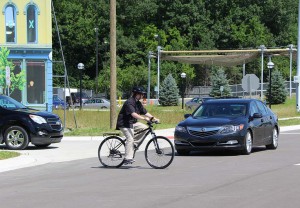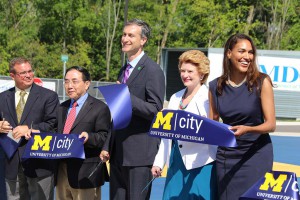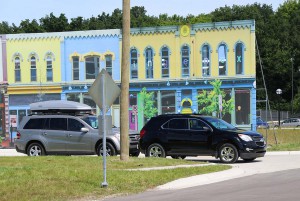It’s not quite up to Hollywood standards, and no one would confuse it for downtown Ann Arbor, but nobody’s going to be living in MCity, anyway. And those who’ll be working there won’t really care about the fake store fronts and the streets that run nowhere.
The 32-acre complex that has risen out of a grassy field on the back of the University of Michigan’s North Campus was designed for one reason: to “create an accelerated learning environment” that will help transform autonomous driving from a concept to reality, said Peter Sweatman, the head of the university’s Transportation Research Institute.
While a number of automakers, as well as tech giant Google, are already testing autonomous vehicles on public roads, MCity will allow them “to take the unusual things that happen on the road and repeat them as often as we want,” helping to ensure that those vehicles will be able to deal with the range of challenges human drivers might face at one point or another.
The $10 million public-private project has drawn a wide range of sponsors including Detroit’s Big Three automakers, Japan’s Toyota, Nissan and Honda, and even China’s Changan Automobile Group. There are some of the world’s largest automotive suppliers, including Detroit-based Delphi and Japan’s Denso, along with major tech and telecomm firms such as Verizon, Xerox and Qualcomm.
(Google autonomous vehicle suffers first injury accident. Click Here for the latest.)
In recent weeks, crews put the final touches on the miniature city, laying out streets, freeway interchanges, fake buildings, sidewalks, traffic lights and street lights. But they’ll be on call to rip things up and redesign them as the development process gets underway, explains Jim Sayer, the MCity project’s development director.
If anything, he contends, participants will be able to test things they couldn’t on real roads, like whether their automatic braking systems properly detect bicyclists, or pedestrians who walk out onto a busy street from behind a big truck.
And while most of the autonomous vehicle testing so far has been done in warm weather venues like California and Nevada, “We think our weather is an advantage,” suggests Sayer, as he watches the official ribbon cutting at the suburban Detroit facility. “We can create all the scenarios you might have to drive through.”
That’s a major challenge for the sensors used in today’s autonomous vehicle prototypes. They have trouble distinguishing between snow, ice and sand, for example. And vision systems meant to keep a car in its lane can be confused when the white stripes fade. They can even be distracted by skid marks, conceded Tesla Motors CEO Elon Musk, during a news conference last week.
Tesla and Google have not yet joined the list of MCity participants, but project organizers hope to bring them aboard soon.
(Tesla could have its new Pilot semi-autonomous technology ready for beta testing within two months, says CEO Musk. Click Here for more.)
Exactly how soon autonomous technology will be on the road is a matter of debate. Tesla hopes to have its Pilot system ready for use later this year. It would provide a limited amount of hands-free driving on highways with well-marked lanes. Mercedes-Benz and Cadillac hope to have similar systems in production by 2017.
Full hands-free driving is more likely to take another five to 10 years, according to Sayer – though Nissan insists its technology will be ready for prime time around 2020.
MCity also will help develop so-called vehicle-to-vehicle and vehicle-to-infrastructure, or V2V and V2I, systems that will alert drivers to traffic jams, crashes, weather issues and other problems. Federal regulators may issue rules mandating that technology in the near future.
The potential payoff is huge, according to Mark Rosekind, the new administrator of the National Highway Traffic Safety Administration. Set to keynote an autonomous vehicle conference in Ann Arbor this week, Rosekind says “There is no way our country should tolerate 32,917 people dying on our roadways,” as they did last year.
Autonomous technology, proponents contend, should slash that number, perhaps to near zero eventually. Meanwhile, it could also smooth traffic on even the most over-crowded highways – roads like the one MCity is meant to simulate.
(Audi shows autonomous form on track, promises to have the tech ready for its next-gen A8. Click Here for more.)




This fake city should be a good start and a proper means to develop AVs, not on the highways until all of the necessary safety devices are installed and operative.
This is exactly how AVs should be developed without endangering the public. The UK just threw a bunch of money at development of AVs and created a “code of practice for AV testing” but it is not compulsory. The “code” however is extremely weak and needs a whole lot more stringent safety requirements along with being statutory.